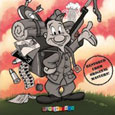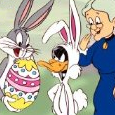Warner Bros. Animation and various (1943-1946), Bosko Video/Image Entertainment (April, 1999), single disc, 130 mins, 1.33:1 windowboxed original full frame ratio, Dolby Digital 1.0 Mono, Unrated, Retail: $24.99
Storyboard:
Chuck Jones, Dr. Seuss, Mel Blanc, and others use a twerpy little soldier to teach soldiers lessons during World War II.
The Sweatbox Review:
During World War II, some of animation’s brightest talents contributed to the War effort by making films for the United States military. Many of us were bowled over by the Disney Wartime set that was released in 2004, but there was a title already out which features 28 wonderful films that had such legendary talents working on them as Dr. Seuss, Chuck Jones, Friz Freleng, Mel Blanc, and Carl Stalling. You will notice that most of those names are normally associated with the Warner Bros. cartoons. If you are one of those toonheads who loves the Disney Wartime or Looney Tunes sets, you could do a lot worse than to take a look at The Complete Uncensored Private Snafu.

Snafu was the brainstorm of Hollywood director Frank Capra, best known now for the films It’s A Wonderful Life and Mr. Smith Goes To Washington. Capra was heading the Armed Forces Motion Picture Unit when he thought up a general idea to use an animated cartoon character as an instrument for teaching lessons to the troops. Many of the GI’s were very young of course, and were naïve in the ways of war and the world. They also had varying degrees of education, so the idea was to present material in a fun manner that would both entertain and educate. Cartoon shorts were still very popular in movie theaters then, and they seemed like a natural way to achieve Capra’s goals. The cartoons would be attached to the Army Navy Screen Magazine newsreel that went overseas.
Capra asked Ted “Dr. Seuss” Geisel to lead the animation section in the Unit, and to develop the Private Snafu idea. Bids were tendered from animation studios, with Disney given the inside track. Disney, however, wanted to own the new character and to have merchandising rights, which was not acceptable. Instead, the bid was won by the Leon Schlesinger studio, producer of the Looney Tunes and Merry Melodies series distributed by Warner Bros. It didn’t hurt that Schlesinger’s bid was about one-third that of Disney’s. The cartoons would be made in black and white to keep the cost down, but would be provided the talents of the best stars that Schlesinger had to offer: directors Friz Freleng, Chuck Jones, Frank Tashlin, and Bob Clampett; music director Carl Stalling; and voice artist supreme Mel Blanc.
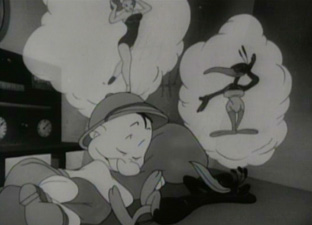
Other Snafu cartoons would be made elsewhere later on, partially due to conflicts between the Unit and Schlesinger about costs. UPA contributed two cartoons, while the Harman-Ising studio would do one. Bill Hanna and Joe Barbera also worked on one (called Hot Spots) with Tex Avery’s unit at MGM, but the completed animation was never put to film since the war ended at that time. Another short called Secrets of the Caribbean was also made but was shelved for reasons unknown. All told, the Snafu cartoons cost nearly $300,000.
The name “Snafu” came from an acronym that was especially popular among the troops back then. Snafu stands for “Situation Normal All F*bleep*ed Up”. In the cartoons, Snafu would generally be shown doing things wrong, whether due to laziness or ignorance, and it was hoped that the troops in the audience would learn from his mistakes. If nothing else, they were treated to some terrific unofficial Looney Tunes cartoons that would not be seen by outsiders for many years.
Speaking of which, current viewers should be aware that you can tell that these cartoons were not made for general audiences. They were not subject to the censors in Hollywood, and were made to appeal to young men. This means there is a little bit of near and partial nudity, and some light cussing (like “hell”). Although quite tame by today’s standards, the content of these cartoons may surprise those accustomed to viewing Daffy Duck and Porky Pig. There is also the issue of racial caricatures. Germans generally do not get drawn too badly, but the Japanese characters seen in the cartoons all have squinty eyes and overbites. The viewer should keep in mind that such caricatures were done throughout cartoons and comic strips at the time, and served to dehumanize “the enemy”, as well as to make him less threatening.
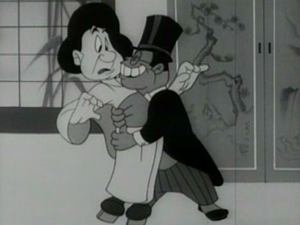
Bosko Video and Image Entertainment put out a DVD back in 1999 that features all of the released Snafu cartoons, as well as an unreleased one— assumedly the one on the disc from 1946, for a total of 28 shorts. This is a nice companion to their Uncensored Bosko DVD, which presented the very earliest Looney Tunes cartoons.
And, Bugs Bunny does make a couple of cameos in Private Snafu, which at the time made this his earliest appearance on DVD.
The disc automatically plays a text introduction as well as a closing, to place these cartoons in a historical context and to provide background knowledge. The introduction makes use of the term “Volume 1”, since this material was originally produced for a VHS set. The shorts follow. At the risk of wearing your patience thin, I will say something brief about every one, since each is interesting in its own way. Note that the UPA ones are incorrectly attributed to MGM in the captions that are shown for a few seconds at the beginning of each cartoon.
Coming! Snafu! – Chuck Jones directed this introduction to the character, with a stripper dream included to get the troops’ attention.
Gripes – Friz Freleng introduces Snafu’s conscience: the cigar-chomping, stubble-ridden and winged Technical Fairy, First Class. Snafu is given his own command to address his gripes. The result is more babes on base, but no discipline.
Spies – Snafu as a blabber. Adolf Hitler himself makes an appearance, and also lends his visage to the devil himself (as seen on the DVD cover).
The Goldbrick – The evils of laziness, with a new “angel” turning into a wartime caricature, in the first “Snafu” by Frank Tashlin.
The Infantry Blues – Snafu learns that being a “dogface” ain’t so bad, as the other Services don’t have it too swank either.
Fighting Tools – Bob Clampett’s first “Snafu” shows the importance of taking care of your weapon. An unprepared Snafu tangles with a German. The recurring “jackass” imagery of these cartoons (with the animal seen from behind) makes an appearance here.
The Home Front – Snafu finds out that people back home are making a contribution too. There’s quite a funny “nuts” gag in this one that would not be in any Looney Tunes cartoon.
Rumors – Well, rumors are dangerous.
Booby Traps – Use your imagination!

SNAFUperman – Decades before Superman and Bugs Bunny were corporate brothers, we see the Looney Tunes animators doing a Superman pastiche. Snafu and the audience learn why map-reading is an important skill.

SNAFU vs. Malaria Mike – This cartoon about the dangers of mosquitoes carrying disease has a parallel today in those areas affected by the West Nile virus. This cartoon gives us a good view (several times) of Snafu’s bottom end.
A Lecture on Camouflage – The Technical Fairy gives this lecture. Even if you’re bored, you may wish to stick around for the topless mermaids.
Gas – Mask safety, with a Bugs Bunny cameo.
Going Home – Another fable about keeping secrets to yourself.
A “Volume 2” intro then plays. This is a remnant of the VHS 2-tape set, wholly unnecessary here since it repeats what we got at the beginning of the disc.
The Chow Hound – A story of a cow’s mission to feed the troops, and Snafu’s wastefulness. (Don’t you know there are starving kids in occupied Europe?)
Censored – Censorship by the unit’s censorship office, as well as self-censorship, helps to save lives.
Outpost – Working at a remote outpost may be boring, but it’s important work. Even reporting a tin can sighting can be important.
Payday – Snafus gambles and buys hookers, instead of saving for his future.

Target SNAFU – Another malaria cartoon, but with a new twist: A mosquito squadron trains to attack the US troops.
A Few Quick Facts: Inflation – This UPA cartoon gives us a new narrator. The animation is more creative, but the story a lot drier.
Three Brothers – Intro to Snafu’s two brothers, Tarfu (Things Are Really F*bleep*ed Up) and Fubar (F*bleep*ed Up Beyond All Repair). Snafu finds out that his brothers also work hard in their parts of the Services. We start to see recycling of themes now, as this message is similar to that in “The Infantry Blues”. Bugs Bunny makes another cameo.
In The Aleutians – Travelogue, with a Jimmy Durante seal.
A Few Quick Facts: Fear – Another straight but visually interesting UPA effort.
It’s Murder She Says… – Less Snafu here, but a return to the malaria message. The structure of this one, at least, is still interesting. We met a lady mosquito treated as a fading movie star.
Hot Spot – The Devil stars in this humorous travelogue about Iran.
Operation: SNAFU – Imagine a Bugs Bunny cartoon, but with espionage and Japanese instead of carrots and Elmer Fudd. This one is pretty much devoid of a message, and is the most routine of all those in the set. It’s still pretty good, though.
No Buddy Atoll – Snafu versus a Japanese admiral on a small island.
Private SNAFU Presents Seaman TARFU – This 1946 cartoon, focusing on Snafu’s brother, looks at Navy life. This was directed by Bruce Gordon at Harman-Ising.
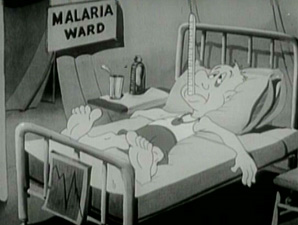
Overall, the first half of the program is really quite good, like slightly raunchy Looney Tunes cartoons with militaristic messages. By the second half, things get a little repetitive, and the UPA ones have a different tone altogether. At their best, though, these cartoons are slickly animated, very funny, and epitomize what was best about the old Warner Bros. cartoons: humorously imperfect characters, perfect timing, sharp writing, and wonderfully complementary music. Plus, the whimsical writing of Dr. Seuss is often apparent in the rhyming dialog.
Is This Thing Loaded?
Aside from the onscreen intro and closing, and the notes on the back of the case, there are no extras to be found. Hmmm… well, the menus do allow you pick individual shorts to watch. Does that count? No, I don’t think so either.
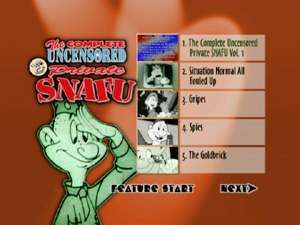
Case Study:
Here’s another snafu: At the time this was released, Image was using snapper cases! At least the back cover has a good listing of titles with release dates.
Ink And Paint:
Now here’s the really bad news. These are old, unremastered cartoons that show their age. Bosko used the best prints they could find, but there are plenty of scratches to be seen, although it’s nothing a viewer can’t get used to. At least the transfer was well done, considering the source material, with no obvious compression artifacting or edge enhancement. There are also other concerns aside from the source material. In an effort to preserve the entire image and to protect against overscanning on your television set, Bosko windowboxed the image, giving a grey or black border (grey for Vol. 1, black for Vol. 2) around the cartoons. It’s a nice idea, but it is a little overdone, making the actual cartoon image relatively small. The screenshot shown here has been left fully intact, while the others were cropped for this review.
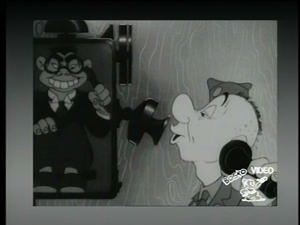
Bosko also inserted their logo for a few seconds during each cartoon, which is slightly distracting; again, I’ve caught a sample of that in the screenshot above for you to judge. I have also previously mentioned that they have an opening caption for each cartoon, which gives the director and year (as well as incorrectly identifying the UPA shorts as being from MGM). Purists may resent even this marring of the original image.
Scratch Tracks:
Naturally, these cartoons are presented in mono. For what it is, the audio is perfectly fine. You will not have any trouble enjoying the vocal performances of Mel Blanc, who makes Snafu sound not unlike Bugs Bunny, or Carl Stalling’s familiar musical themes.

Final Cut:
Of course, a DVD like this you don’t purchase for the stunning picture and sound, or even for bountiful extras. In a sense, the whole DVD is a bonus, as it presents mostly terrific cartoons (from a legendary studio) that most people have never seen. These cartoons are also an important part of history, as they played their own role in the training of US troops in their fight against the Axis. Animation (or WWII) buffs will want to own this, unless they are too turned off by the Bosko logo and excessive window-boxing. You may have a tough time finding this one to rent, and it is unlikely that a better version will be released anytime soon, so collectors definitely may want to pick this up. I’m a collector, and I’m very pleased to have these cartoons in my collection.
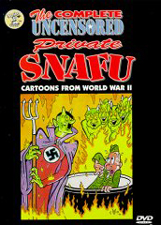 | ||
 |







